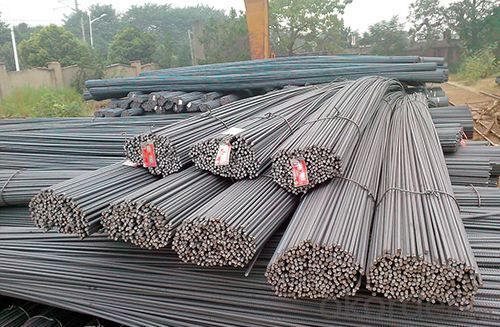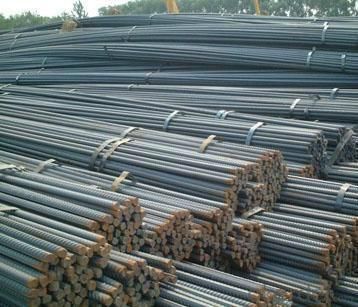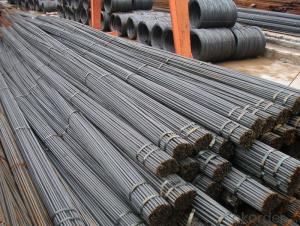Hot Rolled Carbon Steel Deformed Bar 14mm with High Quality
- Loading Port:
- China Main Port
- Payment Terms:
- TT or LC
- Min Order Qty:
- 25 m.t.
- Supply Capability:
- 20000 m.t./month
OKorder Service Pledge
OKorder Financial Service
You Might Also Like
Product Description:
OKorder is offering Hot Rolled Carbon Steel Deformed Bar 14mm with High Quality at great prices with worldwide shipping. Our supplier is a world-class manufacturer of steel, with our products utilized the world over. OKorder annually supplies products to European, North American and Asian markets. We provide quotations within 24 hours of receiving an inquiry and guarantee competitive prices.
Product Applications:
Hot Rolled Carbon Steel Deformed Bar 14mm with High Quality is widely used in buildings, bridges, roads and other engineering construction. Big to highways, railways, bridges, culverts, tunnels, public facilities such as flood control, dam, small to housing construction, beam, column, wall and the foundation of the plate, deformed bar is an integral structure material. With the development of world economy and the vigorous development of infrastructure construction, real estate, the demand for deformed bar will be larger and larger..
Product Advantages:
OKorder's Hot Rolled Carbon Steel Deformed Bar 14mm with High Quality are durable, strong.packed and suitable for construction
Main Product Features:
· Premium quality
· Prompt delivery & seaworthy packing (30 days after receiving deposit)
· Can be recycled and reused
· Mill test certification
· Professional Service
· Competitive pricing
Product Specifications:
Manufacture: Hot rolled
Grade: HRB335 HRB400 BS4449 Grade460 ASTM Grade40 Grade60
Certificates: ISO, SGS, BV, CIQ
Length:6m 8m 9m 12m
Packaging: Export packing, packed by coil
FAQ:
Q1: Why buy Materials & Equipment from OKorder.com?
A1: All products offered byOKorder.com are carefully selected from China's most reliable manufacturing enterprises. Through its ISO certifications, OKorder.com adheres to the highest standards and a commitment to supply chain safety and customer satisfaction.
Q2: How do we guarantee the quality of our products?
A2: We have established an advanced quality management system which conducts strict quality tests at every step, from raw materials to the final product. At the same time, we provide extensive follow-up service assurances as required.
Q3: How soon can we receive the product after purchase?
A3: Within three days of placing an order, we will begin production. The specific shipping date is dependent upon international and government factors, but is typically 7 to 10 workdays.
Q4: How many tons per bundle?
A4: Around 2-3tons
Q5: How to avoid the rust after deliver the goods to the loading port?
A5: We will keep the goods at the port covered with water-proof material
Q6: What is the chemical composition and physical properties of HRB400?
A6
Grade | Technical data of the original chemical composition (%) | ||||||
C | Mn | Si | S | P | V | ||
HRB400 | ≤0.25 | ≤1.60 | ≤0.80 | ≤0.045 | ≤0.045 | 0.04-0.12 | |
Physical capability | |||||||
Yield Strength (N/cm²) | Tensile Strength (N/cm²) | Elongation (%) | |||||
≥400 | ≥570 | ≥14 | |||||
Q7:What is chemical composition and physical properties of 500B?
A7:
BS4449 500B | Chemical Composition | ||||
C | Mn | Si | S | P | |
0.24 | 0.45 | 0.16 | 0.05 | 0.31 | |
Physical capability | |||||
Yield Strength(N/cm²) | Tensile Strength(N/cm²) | Elongation (%) | |||
650 | ≥500 | 19 | |||
Images:


- Q:What is the effect of exposure to chemicals on the durability of steel rebars?
- Exposure to chemicals can have a detrimental effect on the durability of steel rebars. Chemicals, such as acids or salts, can lead to corrosion and the formation of rust on the surface of rebars. This corrosion weakens the structure and compromises its integrity, reducing the lifespan and load-bearing capacity of the rebars. Regular inspection, maintenance, and protective coatings are crucial to mitigate the negative impact of chemical exposure and ensure the long-term durability of steel rebars.
- Q:What is the process of removing rust from steel rebars?
- There are several steps involved in the process of removing rust from steel rebars. Firstly, inspect and assess the rust damage on the rebars. Determine whether the rust is superficial or deeply penetrated and evaluate the overall structural integrity. Before starting the rust removal process, ensure that you have the appropriate personal protective equipment (PPE) on, such as gloves, goggles, and a respirator. This is necessary to protect yourself from any harmful chemicals or debris that may be generated. To clean the surface of the rusted rebars, use a wire brush or a grinder with a brush attachment. This will help remove loose rust, dirt, and other debris. Make sure to thoroughly clean the surface before proceeding. Apply a rust converter or rust remover solution to the rusted areas of the rebar. These solutions contain chemicals that react with the rust, either converting it into a stable compound or dissolving it completely. Follow the manufacturer's instructions for the specific product being used. If the rust has not completely dissolved or converted after the chemical treatment, mechanical methods may be required. This can involve sanding the surface with sandpaper or using a wire brush to scrub off the remaining rust. Once the rust has been removed, rinse the rebars thoroughly with clean water to remove any residual chemicals or debris. Allow the rebars to dry completely before applying any further treatment or protective coatings. To prevent future rusting, it is important to apply a protective coating or paint to the rebars. This acts as a barrier against moisture and air, which are the main causes of rust formation. Choose a high-quality rust-resistant primer and paint specifically designed for steel reinforcement bars. It should be noted that removing rust from steel rebars requires expertise and adherence to safety precautions. In some cases, severe rust damage may require professional assistance or even replacement of the affected rebars.
- Q:Can steel rebars be used in bridges and highways?
- Yes, steel rebars can be used in bridges and highways. Steel rebars provide strength and durability to structures, making them suitable for use in the construction of bridges and highways.
- Q:What is the role of steel rebars in foundation slabs?
- Steel rebars play a crucial role in foundation slabs as they provide reinforcement and strength to the concrete. The rebars are strategically placed within the slab to distribute and withstand the load and stresses that the foundation may experience. This helps prevent cracks, increase durability, and enhance the overall structural integrity of the foundation slab.
- Q:How do steel rebars contribute to the overall sustainability of a construction project?
- Steel rebars contribute to the overall sustainability of a construction project in several ways. Firstly, they enhance the structural integrity and durability of concrete structures, reducing the need for frequent repairs or replacements, thus minimizing material waste and conserving resources. Additionally, steel rebars can be recycled at the end of their life cycle, reducing the demand for new raw materials and decreasing the carbon footprint of the project. Furthermore, their high tensile strength allows for the construction of lighter and more efficient structures, reducing the overall energy consumption during the project's lifespan. Overall, steel rebars play a crucial role in promoting the sustainability of construction projects by ensuring longevity, recyclability, and improved energy efficiency.
- Q:What are the different grades of steel rebars available?
- In the market, there are various grades of steel rebars available, each with its own specific characteristics and applications. The commonly used grades are as follows: 1. Grade 40: This rebar has low strength and is suitable for general construction purposes where high tensile strength is not necessary. It is commonly utilized in residential buildings, sidewalks, and driveways. 2. Grade 60: Offering higher tensile strength than Grade 40, this rebar is of medium strength. It finds wide usage in commercial buildings, bridges, and infrastructure projects. Grade 60 rebar provides excellent reinforcement for heavy loads and ensures structural stability. 3. Grade 75: With exceptional tensile strength, this rebar is of high strength and is often employed in challenging construction projects. It is commonly used in high-rise buildings, parking garages, and industrial structures to ensure superior reinforcement and structural integrity. 4. Grade 80 and higher: These rebars are designed for specialized applications where extreme load-bearing capacity is required. They are commonly used in heavy-duty infrastructure projects, such as dams, tunnels, and nuclear power plants, where the demand for strength is significantly greater. The selection of the grade of steel rebar depends on factors such as the specific construction project, load-bearing requirements, and environmental conditions. Engineers and architects assess these factors to determine the most suitable grade of steel rebar for a particular application, ensuring optimal performance and structural durability.
- Q:Can steel rebars be galvanized for additional protection?
- Yes, steel rebars can be galvanized for additional protection. Galvanizing is a process where a layer of zinc is applied to the surface of the steel rebar. This layer acts as a protective barrier, preventing corrosion and extending the lifespan of the rebar. Galvanized steel rebars are commonly used in construction projects where exposure to moisture, chemicals, or other corrosive elements is expected. The galvanizing process involves dipping the steel rebars into a bath of molten zinc or applying a zinc-rich coating through a hot-dip galvanizing or electroplating process. This results in a durable and corrosion-resistant coating that provides additional protection to the steel rebar, increasing its longevity and reducing maintenance requirements. Overall, galvanizing steel rebars is an effective method of enhancing their protection against corrosion and ensuring their long-term durability in various applications.
- Q:Can steel rebars be used in offshore platform construction?
- Yes, steel rebars can be used in offshore platform construction. They are commonly used as reinforcement in concrete structures, providing strength and durability to withstand the harsh offshore environment and support the weight and loads of the platform.
- Q:Can steel rebars be used in structures with limited accessibility?
- Yes, steel rebars can be used in structures with limited accessibility. Due to their small size and flexibility, rebars can be easily maneuvered and installed in areas with restricted access, making them suitable for various construction projects.
- Q:What are the common problems associated with steel rebars in construction?
- There are several common problems associated with steel rebars in construction. One of the main issues is corrosion. Steel rebars are susceptible to rusting when exposed to moisture and oxygen, especially in humid or coastal environments. This can compromise the integrity of the rebars and weaken the overall structure. Another problem is improper installation. If rebars are not positioned correctly or are not adequately secured, they may not provide the necessary reinforcement and support. This can lead to structural failures and safety hazards. Additionally, the size and spacing of rebars can be a concern. If the rebars are too small or spaced too far apart, they may not effectively distribute loads or resist bending and cracking. On the other hand, if the rebars are too large or placed too close together, it can increase construction costs and make the concrete mix difficult to work with. Another challenge is the potential for poor bonding between the rebar and the concrete. If there is inadequate contact or bonding between the two materials, it can compromise the structural integrity and reduce the load-bearing capacity of the reinforced concrete. Lastly, the quality of the steel rebars themselves can be an issue. Low-quality or substandard rebars may have defects, such as impurities or inconsistencies in their composition, which can weaken the reinforcement and compromise the overall strength of the structure. To mitigate these problems, it is important to use high-quality rebars, follow proper installation techniques, and ensure proper maintenance and protection against corrosion. Regular inspections and testing can also help identify any issues and ensure the longevity and safety of the reinforced concrete structure.
1. Manufacturer Overview |
|
|---|---|
| Location | |
| Year Established | |
| Annual Output Value | |
| Main Markets | |
| Company Certifications | |
2. Manufacturer Certificates |
|
|---|---|
| a) Certification Name | |
| Range | |
| Reference | |
| Validity Period | |
3. Manufacturer Capability |
|
|---|---|
| a)Trade Capacity | |
| Nearest Port | |
| Export Percentage | |
| No.of Employees in Trade Department | |
| Language Spoken: | |
| b)Factory Information | |
| Factory Size: | |
| No. of Production Lines | |
| Contract Manufacturing | |
| Product Price Range | |
Send your message to us
Hot Rolled Carbon Steel Deformed Bar 14mm with High Quality
- Loading Port:
- China Main Port
- Payment Terms:
- TT or LC
- Min Order Qty:
- 25 m.t.
- Supply Capability:
- 20000 m.t./month
OKorder Service Pledge
OKorder Financial Service
Similar products
New products
Hot products
Related keywords




























